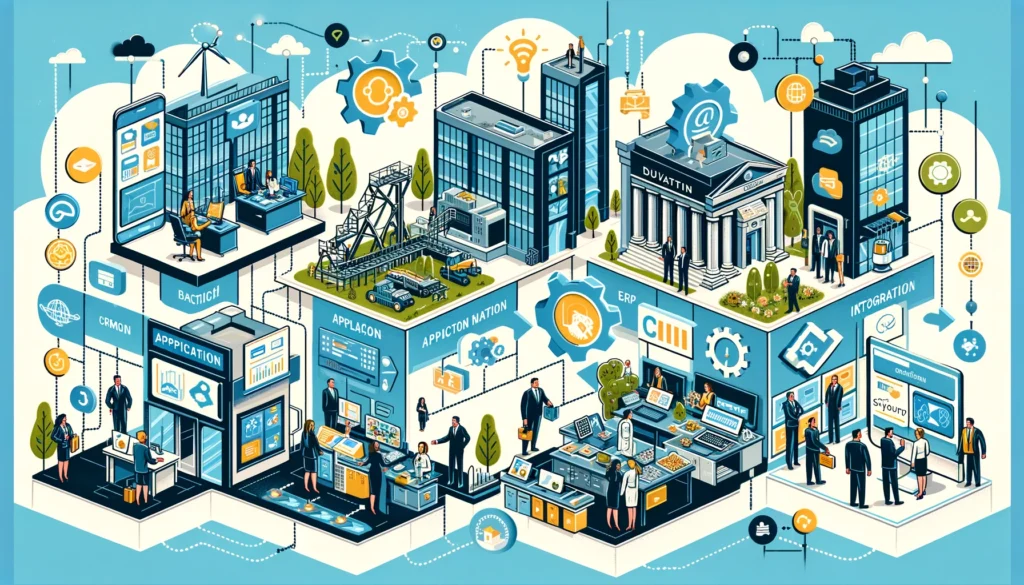Each application is unique : managing sales, tracking inventory, handling customer queries. But often, they’re speaking different languages, siloed in their functions.
This is where application integration steps in, akin to an expert translator who knows every language.
Application integration in the business world refers to the process of seamlessly connecting various business applications, allowing them to communicate and share data efficiently.
Think of it as building bridges between isolated islands, creating a cohesive, interconnected network.
Why is this important for businesses? When business applications are integrated, they can effortlessly share information. Sales data can inform inventory management, customer feedback can enhance marketing strategies, and so forth.
Let’s learn this to its full extent – we will cover its components, types and essential use case.
What is application integration?
Application integration makes different software applications, each built for a specific job, work together. This involves combining and improving the way data and tasks flow between various software, helping organizations update their systems and make their business processes more flexible.
This approach is key to connecting older, on-site systems with newer, cloud-based programs.
By ensuring smooth interaction and data sharing between these systems, application integration lets companies manage a range of activities across their whole setup, making them run more smoothly and efficiently.
You can usually do application integration using middleware or connectors to transfer data. If there’s no middleware, it requires custom coding, using APIs (Application Programming Interfaces), and doing some tasks manually.
Components of Application Integration
In application integration, there are several key parts needed to successfully link processes between two or more applications.
Application Programming Interface (API): An API is a set of rules and procedures that outlines how software components interact. They provide a way for developers to access the functions of other software easily through well-defined data structures. This has made APIs a popular method for linking applications, data, and services recently.
Events and Actions: An event in your integrated applications could be something like receiving a payment. This event triggers an action or a series of actions. These actions can range from basic tasks like creating, retrieving, or updating data sets, to more specific tasks like creating a new case in Salesforce
Data Mapping: Data mapping is simply defining how information will be exchanged. For instance, when you fill out and submit a contact form in one application, this can prompt actions in another application. These actions map the form fields to corresponding data sets in other applications, organizing the information into categories like first name, last name, status, etc. This makes it easier to export and analyze data.

Types of Application Integration
Here are the 4 most common types of application integration that you’ll notice in use –
Presentation Level Integration: This approach combines two or more apps into one by creating a shared User Interface (UI). Despite being considered somewhat outdated, it’s still used for smaller apps due to its simplicity.
- Benefits: Unified UI, consolidated information.
- Limitations: Less sophisticated, seen as outdated.
Business Process Integration: Aims to boost efficiency through automation. It links apps to streamline workflows, like connecting CRM and accounting software so that an order in the CRM automatically generates an invoice.
- Benefits: Enhances workflow efficiency, reduces errors, allows focus on high-value tasks, cuts operational costs.
- Limitations: Increased security risks, potential system-wide issues.
Data Integration: Allows data systems to exchange information. Essential as data grows in volume and variety, it often involves an intermediate data format or custom coding for communication.
- Benefits: Improved data quality, unified data source, better collaboration, enhances business intelligence, increases efficiency.
- Limitations: Complexity in handling diverse data, high resource demands for large data volumes, issues with outdated or poor-quality data.
Communication Level Integration: Used in both business process and data integration, this focuses on how apps communicate, typically through APIs. It includes methods like Point-to-Point, Hub-and-Spoke, and Enterprise Service Bus (ESB).

Top Use Cases of Application Integration
Banking: In banking, application integration involves linking core banking systems with mobile banking platforms using API gateways. This integration allows for real-time data synchronization, enabling customers to check balances, perform transactions, and apply for loans directly through their mobile apps. Application integration here is crucial for delivering a seamless digital banking experience, with secure OAuth protocols ensuring data safety during these interactions.
Healthcare: Healthcare sees application integration in the form of integrating diverse patient records into centralized Electronic Health Records (EHR) systems, using health data standards like HL7 or FHIR. This integration ensures that caregivers have access to comprehensive, up-to-date patient information. Secure API frameworks enhance this integration, allowing various systems to contribute to a unified patient record, significantly improving care coordination.
Manufacturing: In the manufacturing sector, application integration plays a big role by connecting Industrial IoT devices on the production line with Manufacturing Execution Systems (MES) and ERP systems. This setup, often facilitated through middleware or direct API communication, enables real-time monitoring and control over manufacturing processes. The data collected is analyzed in the cloud, optimizing production efficiency and supply chain management, a testament to the power of application integration in modern manufacturing.
CRM Platforms: For CRM platforms, application integration means linking CRM software with marketing automation tools and data analytics platforms. This integration, enabled by APIs, allows systems to exchange data, enabling businesses to automate marketing campaigns, track leads more efficiently, and offer personalized customer service. Application integration here provides a comprehensive view of customer interactions, showcasing its role in enhancing customer relationship management.
ERP Systems: In the context of ERP systems, application integration involves connecting ERP software with other business applications like CRM or supply chain management tools. This is achieved using API management tools that facilitate data flow between cloud-based services and the ERP system. Such integration streamlines and automates crucial business processes, enhancing operational efficiency and demonstrating the transformative impact of application integration in enterprise resource planning.
Examples of Application Integration
Case 1: When marketers run drip campaigns, it’s vital for sales reps to know when a prospect is ready for a conversation. By integrating the CRM system with the marketing automation tool, sales reps can be automatically alerted when a prospect’s lead score indicates they’re ready for sales. This allows for timely and more effective outreach.
Case 2: As the client base grows, keeping track of invoices can be challenging. By syncing an ERP system like NetSuite with a communication platform like Slack, finance teams can receive immediate notifications in Slack when a client payment is overdue. This integration enables quicker actions for invoice management and payment collection.
Case 3: For organizations using third-party call centers, some client issues need escalation to the internal team. By linking the IT Service Management (ITSM) tools used by both parties, an automation can be set up to alert the internal team whenever a significant issue arises, ensuring timely and effective issue resolution.
Whether it’s ensuring your sales team knows exactly when to reach out to hot leads, or your finance crew getting a nudge the moment an invoice slips past due, application integration is going to make life at work smoother and less of a headache.
So, why not leverage it? Dive in, and watch how it transforms the little things – because, in business, it’s those little things that add up to big success.
Work with us at Segwitz, your very own tech strategist and innovation partner with a solid team of web and mobile app developers. We believe in making your vision a reality and help you end-to-end.
If you found this useful and want to encourage us to create more, share this with someone who’d enjoy this read.
For more content on technology, mobile app development, and tech case studies, head over to our blog section.
See ya.





 Booking System
Booking System eCommerce
eCommerce On-Demand Services
On-Demand Services Community App
Community App Ordering App
Ordering App Loyalty App
Loyalty App Online Learning
Online Learning Directory
Directory Marketplace
Marketplace SaaS
SaaS P2P Platform
P2P Platform eHailing
eHailing Healthcare
Healthcare Finance
Finance Logistics
Logistics Education
Education Food & Beverage
Food & Beverage Retail
Retail FMCG
FMCG Sports
Sports Travelling
Travelling Manufacturing
Manufacturing Renewable Energy
Renewable Energy Mobile Application Development
Mobile Application Development Web Application Development
Web Application Development Source Code Review
Source Code Review Internet of Things (IoT)
Internet of Things (IoT) Cyber Security
Cyber Security SegWitz SandBox – Dev-Team as Subscription
SegWitz SandBox – Dev-Team as Subscription SegWitz Streamline – SOP Systemization
SegWitz Streamline – SOP Systemization SegWitz ScaleUp – Tech Transformation of SME & PLC
SegWitz ScaleUp – Tech Transformation of SME & PLC SegWitz StartUp – MVP & Scaling
SegWitz StartUp – MVP & Scaling